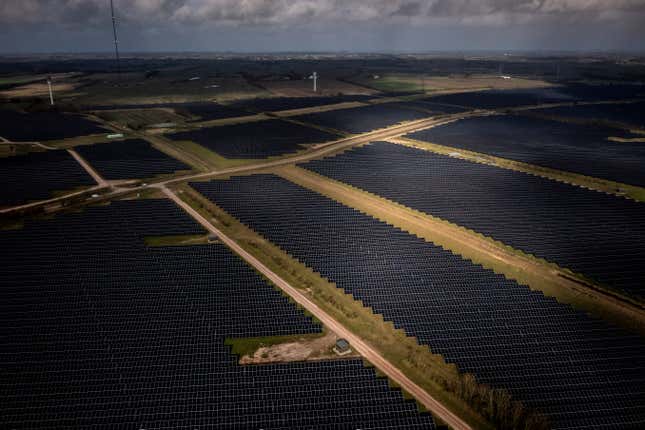
Russia’s invasion of Ukraine last February, and Moscow’s subsequent throttling of natural gas supplies to Europe, threw global energy markets into disarray.
Europe panicked as it confronted the ugly reality of its fragile energy security. It scrambled to buy liquified natural gas (LNG) from the US, and loaded up on heat pumps from China. And, it turns out, Europe also stockpiled Chinese solar panels.
Some €7 billion ($7.8 billion) worth of solar panels—or 40 gigawatts direct current (GWdc) of capacity—are currently sitting unused in European warehouses, according to new research by Rystad Energy, a Norway-headquartered consultancy. And the stockpile is forecast to grow even larger this year, hitting 100 GWdc in storage by the end of 2023.
Europe is stockpiling Chinese solar panels
The ballooning hoard of uninstalled solar panels is due in part to booming imports. As it sought to reduce dependence on Russian fuels, Europe bought a record amount of solar panels last year, more than doubling 2021 levels by capacity, according to Rystad data.
In part, volatile prices of solar panels throughout 2021 and part of last year incentivized European buyers to increase imports when they were relatively inexpensive, Marius Mordal Bakke, a senior analyst at Rystad, told Quartz.
Meanwhile, the US’s enactment of the Uyghur Forced Labor Prevention Act in December 2021, which bars imports from the Chinese region of Xinjiang, where Beijing has carried out a years-long repressive campaign against Uyghurs and other ethnic minorities, meant that “Europe has become an increasingly more important market for Chinese manufacturers following US tariffs,” Bakke added. Europe is still working on proposed draft rules for a similar ban.
From energy dependence on Russia to solar dependence on China
When Europe slashed energy dependence on Russia, it increased solar dependence on China. Rystad data shows that over 90% of Europe’s solar panel imports last year came from China, a big jump from 37% in 2018. Other sources of imports include Malaysia, Japan, Taiwan, and the US.
And swapping dependency on one autocracy for another—especially when both have proven more than willing to weaponize economic relations for political gain—would appear to be at best a short-term solution to Europe’s energy security conundrum.
For now, Europe is working to ramp up its own production of solar panels. But it faces two challenges, says Bakke.
One is that Europe lacks the capacity to produce the materials and inputs needed to make solar panels, such as high-purity polysilicon, silicon ingots, and silicon wafers.
“[Europe] is still severely lacking capacity on earlier PV value chain commodities, meaning that they are still ways off an independent solar supply chain,” said Bakke, referring to the upstream inputs in the photovoltaic supply chain.
Stockpiling Chinese solar panels is one way to plug the shortfall in Europe’s own manufacturing capacities. But the flood of cheap Chinese imports could threaten European manufacturers.
“The fact that we have such high panel inventories in Europe could also lead to less or delayed ramp-ups along the European [photovoltaic] value chain as there is simply too much competition in the market,” Bakke added.